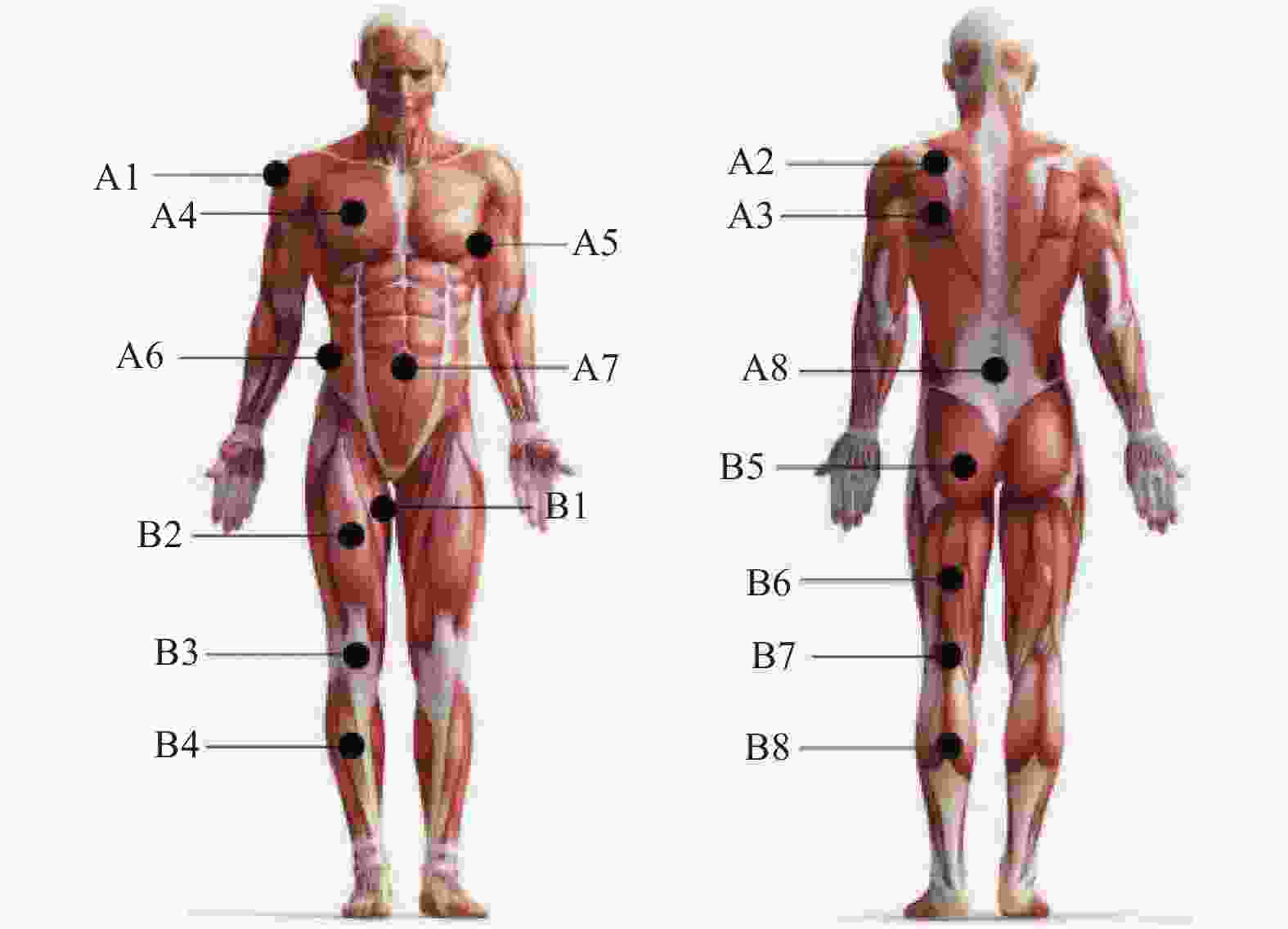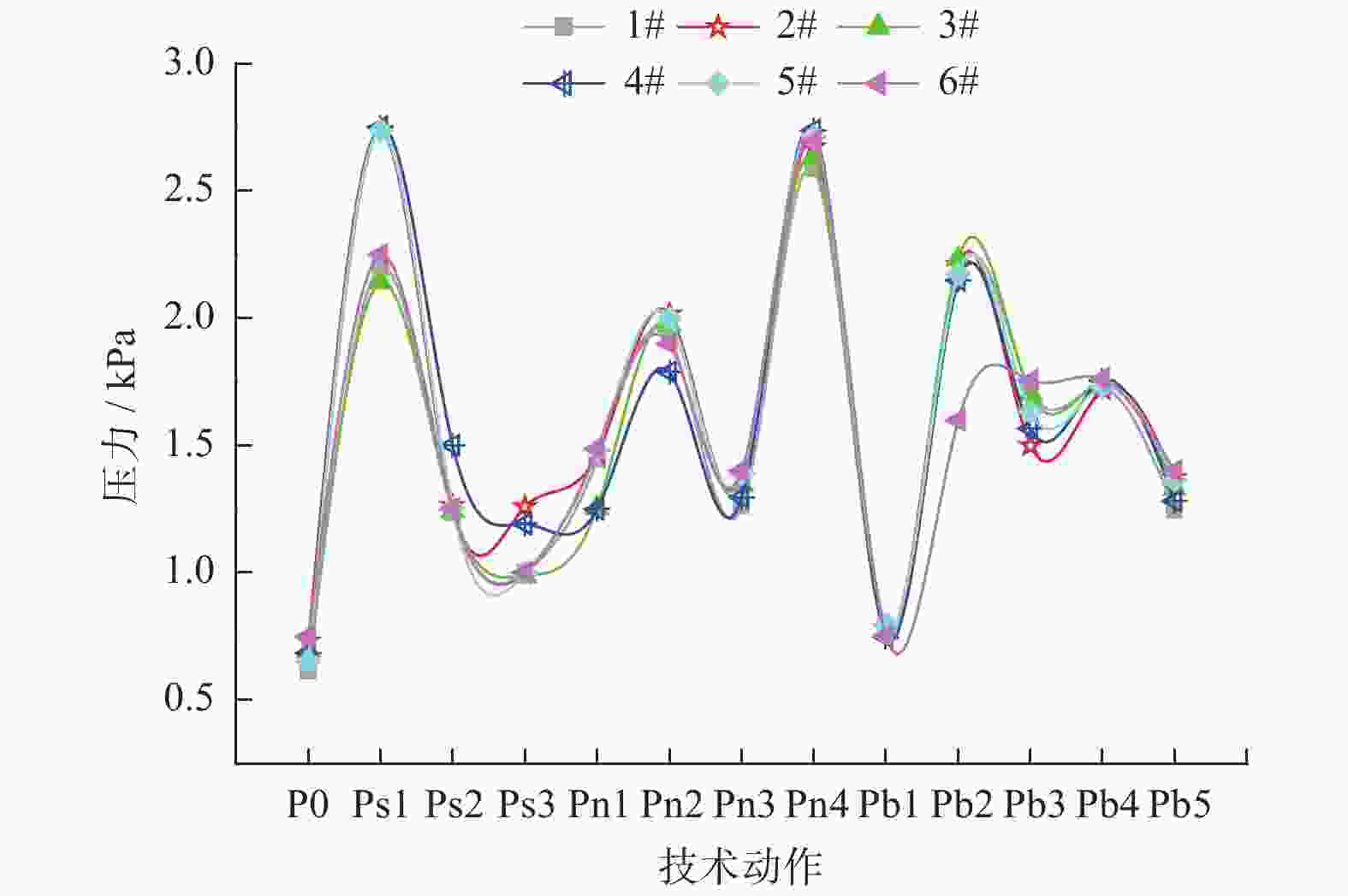Evaluation of pressure comfort of indoor climbing tight sportswear
-
摘要:
为提升室内攀岩紧身运动服在不同技术动作下的压力舒适性,通过不同结构分割及面料拼接设计4款紧身攀岩运动服,与市场较受欢迎的两款进行着装对比试验. 分析测试点压力值,确定存在超出压力舒适阈值的点;通过相关性分析确定主要受力部位为肩部、腰膝部及臀部;采用视频软件捕捉人体攀岩动作,并对主要压力部位测试点进行主成分分析,确定影响压力大小的4个主要技术动作. 最后对6款试验服装在4个主要技术动作下各测试点的压力值进行权重分析. 结果表明,采用插肩袖设计,在前胸、背宽等部位进行分割线设计,适当增加膝前片弯曲量、减少膝后片松量,均可有效提升攀岩服装的压力舒适性.
Abstract:In order to improve the pressure comfort of indoor climbing tight sportswear under different technical actions, four tight-fitting climbing sportswear were designed through different structural divisions and fabric splicing, and the dress comparison experiment was carried out with the popular two in the market. The pressure value of each test point was analyzed, and the point that exceeded the pressure comfort threshold was determined. Through correlation analysis, it was found that the main pressure parts were the shoulders, waist, knees and hips. The human rock climbing action was captured by video software, and the principal component analysis of the test points of the main pressure parts was carried out to determine the 4 main technical actions that affected the pressure. Finally, weight analysis of the pressure value of each test point of the 6 experimental garments under the 4 main technical actions was carried out. The results show that these methods mentioned can effectively improve the pressure comfort of climbing sportswear, including the use of raglan sleeve design and dividing line design on the front chest, back width and other parts, appropriately increasing the bending amount of the front knee and reducing the looseness of the back of the knee.
-
Key words:
- indoor climbing /
- tight sportswear /
- pressure comfort /
- principal component analysis
-
表 1 面料机械性能排序
Table 1. Sorting of fabric mechanical performance
性能 排序 经向拉伸性能 2#>1#>4#>5#>3# 纬向拉伸性能 3#>5#>2#>1#>4# 耐磨性能 2#>1#>5#>3#>4# 起毛性能 3#>1#>2#>4#>5# 顶破性能 2#>1#>5#>4#>3# 透气性能 5#>3#>4#>1#>2# 保暖性能 3#≥4#>1#>5#>2# 透湿性能 3#>1#>4#>2#>5# 吸湿性能 4#>3#>2#>1#≥5# 表 2 成衣尺寸
Table 2. Garment size
部位 衣长 胸围 腰围 肩宽 袖长 袖口 裤长 臀围 裆长 裤口 尺寸/cm 65.0 91.2 74.0 43.6 25.0 28.0 93.0 92.0 25.0±2 19.4 表 3 试验对象基本信息
Table 3. Basic information of experimental subjects
参数 身高/cm 体重/kg 肩宽/cm 胸围/cm 腰围/cm 臀围/cm 平均值 172.60 63.20 43.97 90.50 73.97 92.60 标准差 1.04 3.13 0.21 0.57 0.57 0.69 表 4 技术动作说明
Table 4. Technical action description
代号 专业术语 动作说明 Ps1 High Step高踩 用脚尖踩住腰部附近岩点,支撑大腿,将下半身向上推动 Ps2 Elbow Bending 翘肘 攀登力竭时,攀登者手臂弯曲,身体贴近岩壁,肘朝外翘起 Ps3 Summit 登顶 双手紧握上方岩点,脚尖踩住岩点,向上登顶的过程 Pn1 Laybacking 侧拉 手脚同侧,重心侧向一边,人体侧挂在岩壁上,紧贴岩壁 Pn2 Sit Start 蹲坐 双腿深蹲,手臂向上拉住岩点,人体呈现吊挂姿势 Pn3 Largo Start 蹿跳 攀登时岩点很高,需要蹿跳时的姿势 Pn4 Heel Hooking 脚勾 脚跟勾住岩点,借用手臂力量向上移动 Pb1 Twist Locking 扭锁 主作用部位为左手配右脚(或右手配左脚),侧身锁定身体,只需一脚一手支撑 Pb2 Counter Balance 平衡 向一方伸出手,同时向另一方伸出脚平衡身体,此动作可省回双臂用在平衡上的体力(无固定招式,全凭实战中领悟发挥) Pb3 Stride Step 跨越 双脚间距较大,向侧跨越,用于横移和抱石 Pb4 Deadpoint 跳跃 攀岩过程中,在跳起到落的刹那轻抓下一岩点的动作 Pb5 Layback Pendum 侧荡 利用三点平衡,像秋千一样荡过去,用于借助支点的横切攀岩 表 5 各测试点压力舒适阈值范围
Table 5. Pressure comfort threshold range of each test point
测试点 压力阈值范围/kPa 测试点 压力阈值范围/kPa A1 2.38~3.39 B1 0.58~1.27 A2 0.51~1.86 B2 0.58~1.27 A3 0.66~0.97 B3 2.30~3.20 A4 0.48~1.00 B4 0.49~2.60 A5 0.37~0.71 B5 0.78~1.27 A6 0.49~2.60 B6 0.78~0.88 A7 0.49~2.46 B7 0.49~2.60 A8 0.49~2.60 B8 0.49~2.60 表 6 方差贡献率
Table 6. Variance contribution rate
起始特征值 提取平方和载入 元件 合计 方差% 累计% 合计 方差% 累计% 1 7.912 65.930 65.930 7.912 65.930 65.930 2 2.224 18.532 84.461 2.224 18.532 84.461 3 1.259 10.492 94.954 1.259 10.492 94.954 4 0.606 5.046 100.000 5 1.53E−15 1.277E−14 100.000 6 5.486E−16 4.571E−15 100.000 7 2.858E-16 2.382E−15 100.000 8 1.310E−16 1.092E−15 100.000 9 1.658E−17 1.382E−16 100.000 10 −9.613E−17 −8.011E−16 100.000 11 −1.536E−16 −1.280E−15 100.000 12 −5.987E−16 −4.989E−15 100.000 表 7 因子载荷矩阵
Table 7. Factor loading matrix
技术动作 成分 1 2 3 X1 0.712 0.660 0.099 X2 0.719 0.562 −0.409 X3 0.815 −0.570 0.095 X4 0.840 0.100 −0.509 X5 0.862 −0.184 0.415 X6 0.937 0.018 0.101 X7 0.813 −0.575 0.076 X8 0.996 0.084 0.009 X9 0.858 −0.222 −0.006 X10 −0.531 0.520 0.657 X11 0.692 0.667 0.037 X12 0.864 0.044 0.439 表 8 主成分得分系数矩阵
Table 8. Principal component score coefficient matrix
技术动作 成分 1 2 3 X1 0.090 0.297 0.078 X2 0.091 0.253 −0.325 X3 0.103 −0.256 0.076 X4 0.106 0.045 −0.404 X5 0.109 −0.083 0.329 X6 0.118 0.008 0.081 X7 0.103 −0.258 0.060 X8 0.126 0.038 0.007 X9 0.108 −0.100 −0.005 X10 −0.067 0.234 0.522 X11 0.088 0.300 0.030 X12 0.109 0.020 0.348 表 9 方差贡献率
Table 9. Variance contribution rate
成分 起始特征值 提取平方和载入 合计 方差% 累计% 合计 方差% 累计% 1 5.942 99.037 99.037 5.942 99.037 99.037 2 0.052 0.864 99.901 3 0.006 0.099 100.000 4 1.577E−16 2.628E−15 100.000 5 −2.574E−16 −4.290E−15 100.000 6 −1.780E−15 −2.966E−14 100.000 表 10 因子载荷矩阵
Table 10. Factor loading matrix
试验服装 成分1 X1 0.997 X2 0.994 X3 1.000 X4 0.998 X5 0.982 X6 1.000 表 11 主成分得分系数矩阵
Table 11. Principal component score coefficient matrix
试验服装 成分1 X1 0.170 X2 0.167 X3 0.169 X4 0.166 X5 0.162 X6 0.164 -
[1] 张永杨, 丛杉. 室内攀岩人体尺寸变化对服装结构的影响[J] . 毛纺科技,2021,49(8):60 − 66. [2] 胡月. 攀岩运动参与人群的锻炼动机研究: 以天津市部分参与者为例[J] . 文体用品与科技,2020(6):48 − 49. doi: 10.3969/j.issn.1006-8902.2020.06.023 [3] BERTUZZI R C, FRANCHINI E, KOKUBUN E, et al. Energy system contributions in indoor rock climbing[J] . European Journal of Applied Physiology,2007,101(3):293 − 300. doi: 10.1007/s00421-007-0501-0 [4] MERMIER C M, ROBERGS R A, MCMINN S M, et al. Energy expenditure and physiological responses during indoor rock climbing[J] . British Journal of Sports Medicine,1997,31(3):31. [5] 谢月. 国内外攀岩运动服装的现状与发展趋势预测[J] . 轻纺工业与技术,2021,50(9):94 − 95. doi: 10.3969/j.issn.2095-0101.2021.09.042 [6] 王琦. 紧身型运动服装分割线设计研究[D]. 北京: 北京服装学院, 2013. [7] DUFFIELD R, CANNON J, KING M. The effects of compression garments on recovery of muscle performance following high-intensity sprint and plyometric exercise[J] . Journal of Science and Medicine in Sport,2010,13(1):136 − 140. doi: 10.1016/j.jsams.2008.10.006 [8] 蔡娟娟, 李亚宁, 陆阿明, 等. 紧身运动装压迫对人体运动机能的影响[J] . 现代丝绸科学与技术,2013,28(2):67 − 71. doi: 10.3969/j.issn.1674-8433.2013.02.010 [9] BROATCH J R, BISHOP D J, HALSON S. Lower limb sports compression garments improve muscle blood flow and exercise performance during repeated-sprint cycling[J] . International Journal of Sports Physiology & Performance,2018,13(7):882 − 890. [10] MIZUNO S, ARAI M, TODOKO F, et al. Wearing compression tights on the thigh during prolonged running attenuated exercise-induced increase in muscle damage marker in blood[J] . Frontiers in Physiology,2017,8:834. doi: 10.3389/fphys.2017.00834 [11] 张同会. 基于压力舒适性的女大学生骑行裤优化设计研究[D]. 西安: 西安工程大学, 2018. [12] 孙锋. 针织运动服装及其面料的研究[J] . 上海纺织科技,2004,32(6):34 − 36. doi: 10.3969/j.issn.1001-2044.2004.06.017 [13] 张弦. 功能性运动服装用新型纺织纤维[J] . 棉纺织技术,2003,31(9):575 − 576. [14] 张文斌. 服装制版提高篇[M]. 2版. 上海: 东华大学出版社, 2018. [15] 黄建华. 服装的舒适性[M]. 北京: 科学出版社, 2008. [16] 王启树. 攀岩运动专项上肢力量素质训练的表面肌电特征[D]. 成都: 成都体育学院, 2018. [17] 杨建伟. 攀岩运动员膝关节不同角度屈伸时等速肌力及表面肌电特征研究[D]. 金华: 浙江师范大学, 2012. [18] 黄丽萍. 基于压力舒适性的青年女性连体泳装结构优化设计研究[D]. 西安: 西安工程大学, 2019. [19] 王二会. 基于骑行动作下的日常弹力紧身裤版型优化研究[D]. 上海: 东华大学, 2020. [20] 张晓旭. 女式针织牛仔裤臀部压力舒适性评价[J] . 针织工业,2018(1):83 − 85. doi: 10.3969/j.issn.1000-4033.2018.01.019 -






 下载:
下载:







